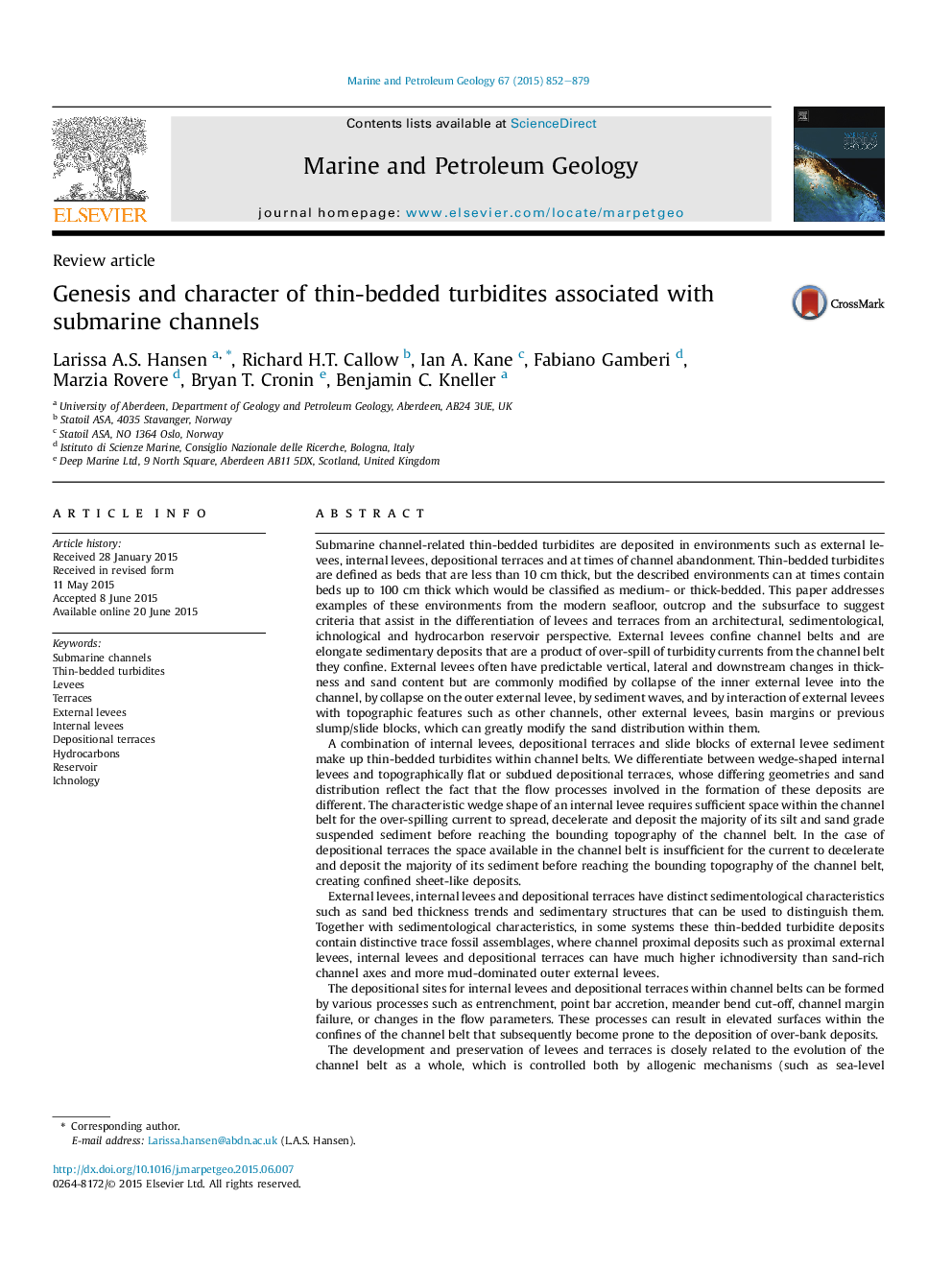| کد مقاله | کد نشریه | سال انتشار | مقاله انگلیسی | نسخه تمام متن |
|---|---|---|---|---|
| 6434874 | 1637159 | 2015 | 28 صفحه PDF | دانلود رایگان |
- Levees have a wedge shape
- External levees confine channel-belts, internal levees confine channels
- Channel belt thin-bedded turbidites are internal levees and depositional terraces
- Terraces are flat surfaces or deposits within channel-belts
- Preservation of thin-bedded turbidites depends on channel belt evolution
Submarine channel-related thin-bedded turbidites are deposited in environments such as external levees, internal levees, depositional terraces and at times of channel abandonment. Thin-bedded turbidites are defined as beds that are less than 10Â cm thick, but the described environments can at times contain beds up to 100Â cm thick which would be classified as medium- or thick-bedded. This paper addresses examples of these environments from the modern seafloor, outcrop and the subsurface to suggest criteria that assist in the differentiation of levees and terraces from an architectural, sedimentological, ichnological and hydrocarbon reservoir perspective. External levees confine channel belts and are elongate sedimentary deposits that are a product of over-spill of turbidity currents from the channel belt they confine. External levees often have predictable vertical, lateral and downstream changes in thickness and sand content but are commonly modified by collapse of the inner external levee into the channel, by collapse on the outer external levee, by sediment waves, and by interaction of external levees with topographic features such as other channels, other external levees, basin margins or previous slump/slide blocks, which can greatly modify the sand distribution within them.A combination of internal levees, depositional terraces and slide blocks of external levee sediment make up thin-bedded turbidites within channel belts. We differentiate between wedge-shaped internal levees and topographically flat or subdued depositional terraces, whose differing geometries and sand distribution reflect the fact that the flow processes involved in the formation of these deposits are different. The characteristic wedge shape of an internal levee requires sufficient space within the channel belt for the over-spilling current to spread, decelerate and deposit the majority of its silt and sand grade suspended sediment before reaching the bounding topography of the channel belt. In the case of depositional terraces the space available in the channel belt is insufficient for the current to decelerate and deposit the majority of its sediment before reaching the bounding topography of the channel belt, creating confined sheet-like deposits.External levees, internal levees and depositional terraces have distinct sedimentological characteristics such as sand bed thickness trends and sedimentary structures that can be used to distinguish them. Together with sedimentological characteristics, in some systems these thin-bedded turbidite deposits contain distinctive trace fossil assemblages, where channel proximal deposits such as proximal external levees, internal levees and depositional terraces can have much higher ichnodiversity than sand-rich channel axes and more mud-dominated outer external levees.The depositional sites for internal levees and depositional terraces within channel belts can be formed by various processes such as entrenchment, point bar accretion, meander bend cut-off, channel margin failure, or changes in the flow parameters. These processes can result in elevated surfaces within the confines of the channel belt that subsequently become prone to the deposition of over-bank deposits.The development and preservation of levees and terraces is closely related to the evolution of the channel belt as a whole, which is controlled both by allogenic mechanisms (such as sea-level fluctuations, changes in turbidity current size and sediment calibre, and changes in the equilibrium profile of the channel), and by autogenic mechanisms (such as channel avulsion and resulting knick-point migration). Where preserved in the rock record thin-bedded turbidites have been uncommon primary targets for hydrocarbon field development, since most efforts have focused on the channel-fills which have the highest proportion of sand. However, thin-bedded turbidites can contain large amounts of sand, of which individual beds can be very laterally continuous, and hence can make significant secondary reservoir targets.
Journal: Marine and Petroleum Geology - Volume 67, November 2015, Pages 852-879
